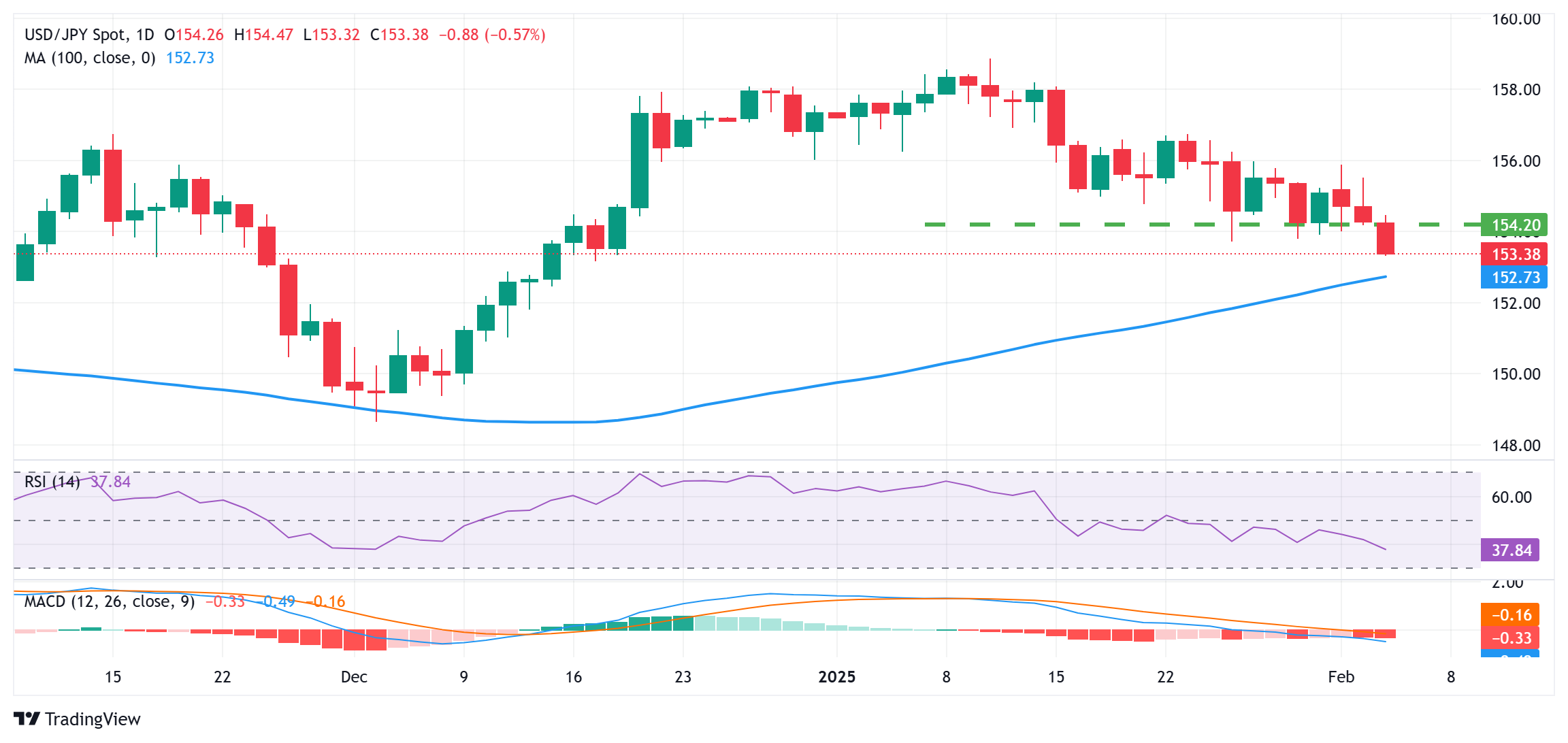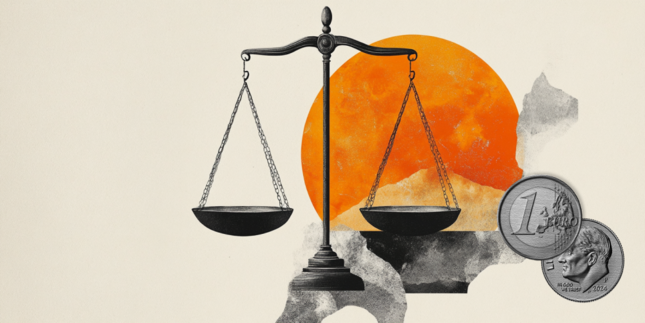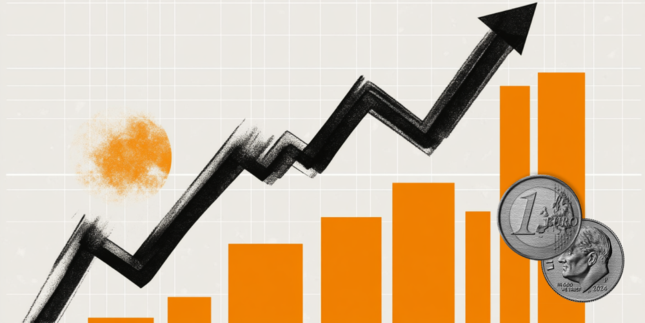Japanese Yen sticks to strong gains against USD; seems poised to appreciate further
- The Japanese Yen jumps to over a one-month top against the USD amid BoJ rate hike bets.
- Expectations for a further narrowing of the Japan-US rate differential also underpin the JPY.
- A positive risk tone might cap the safe-haven JPY amid worries about Trump’s trade tariffs.
The Japanese Yen (JPY) sticks to strong intraday gains. though it has retreated a few pips from the highest level since December 13 touched against its American counterpart during the Asian session. Data released earlier this Wednesday showed a rise in Japan's real wages, which reaffirms bets that the Bank of Japan (BoJ) will raise interest rates again. This marks a big divergence in comparison to expectations that the Federal Reserve (Fed) will lower borrowing costs twice by the end of this year and turns out to be a key factor underpinning the lower-yielding JPY.
Meanwhile, investors remain worried that Japan would also be an eventual target for US President Donald Trump's tariffs. Apart from this, the prevalent risk-on environment holds back traders from placing fresh bullish bets around the safe-haven JPY. That said, the fundamental backdrop seems tilted in favor of the JPY bulls, which, along with a weaker US Dollar (USD), might cap any attempted recovery for the USD/JPY pair.
Japanese Yen is underpinned by hawkish BoJ expectaions, despite the risk-on mood
- Preliminary government data released earlier this Wednesday revealed that inflation-adjusted real wages in Japan climbed 0.6% from the year before in December. Adding to this, the previous month's reading was revised to show a 0.5% rise against a 0.3% drop reported originally.
- Meanwhile, the consumer inflation rate that the government uses to calculate real wages accelerated from November's 3.4% to 4.2%, or the fastest pace since January 2023. This, in turn, supports prospects for further policy tightening by the Bank of Japan and lifts the Japanese Yen.
- BoJ's Director General of monetary affairs Kazuhiro Masaki said that the central bank sees underlying inflation gradually heading toward 2% and services prices are rising moderately.Price rises post-pandemic have been driven mostly by cost push factors, Masaki added further.
- A survey compiled by S&P Global Market Intelligence showed that Japan's service activity expanded for a third straight month in January. In fact, the au Jibun Bank Service Purchasing Managers’ Index (PMI) rose from 50.9 to 53.0 in January, marking the highest level since September 2024.
- The US Bureau of Labor Statistics (BLS) reported in the Job Openings and Labor Turnover Survey (JOLTS) on Tuesday that the number of job openings on the last business day of December stood at 7.6 million. This was below the 8.09 million openings in November and expectations of 8 million.
- The data pointed to a slowdown in the job market, which could allow the Federal Reserve to cut rates further. This marks a big divergence in comparison to the hawkish BoJ expectations and drags the USD/JPY pair to over a one-month low during the Asian session on Wednesday.
- Fed Vice Chairman Philip Jefferson said on Tuesday that there is no need to hurry further rate cuts as a strong economy makes caution appropriate. Interest rates are likely to fall over the medium term and the Fed faces uncertainty around government policy, Jefferson added further.
- US President Donald Trump offered concessions to Canada and Mexico by delaying the 25% trade tariffs for 30 days. Adding to this hopes for a trade breakthrough between the US and China help to ease trade war fears and remain supportive of the prevalent risk-on environment.
- Investors remain worried that Japan would also be an eventual target for Trump's trade tariffs. Japan's Prime Minister Shigeru Ishiba is set to meet with Trump later this week and their conversation may provide more hints about the risk as Japan has a large trade surplus with the US.
- Traders now look forward to the US economic docket – featuring the release of the ADP report on private-sector employment and the ISM Services PMI. The data provide some impetus to the US Dollar ahead of the closely-watched US Nonfarm Payrolls report on Friday.
USD/JPY bears have the upper hand, might aim to test 100-day SMA support near 152.45
From a technical perspective, the intraday breakdown and acceptance below the 154.00 mark could be seen as a fresh trigger for bearish traders. Moreover, oscillators on the daily chart have been gaining negative traction and are still away from being in the oversold territory. This, in turn, suggests that the path of least resistance for the USD/JPY pair is to the downside and supports prospects for a further depreciating move. Hence, a subsequent fall towards the 153.00 mark, en route to the 100-day Simple Moving Average (SMA), currently pegged near the 152.45 region, looks like a distinct possibility.
On the flip side, any attempted recovery might now confront immediate resistance near the 154.00 round figure. Some follow-through buying, however, might prompt a short-covering rally and lift the USD/JPY pair to the 154.70-154.75 intermediate hurdle en route to the 155.00 psychological mark. Meanwhile, a further move up could be seen as a selling opportunity and remain capped near the 155.25-155.30 region. The latter should act as a key pivotal point, which if cleared decisively will negate the negative outlook and shift the near-term bias in favor of bullish traders.
Japanese Yen PRICE Today
The table below shows the percentage change of Japanese Yen (JPY) against listed major currencies today. Japanese Yen was the strongest against the Australian Dollar.
| USD | EUR | GBP | JPY | CAD | AUD | NZD | CHF | |
|---|---|---|---|---|---|---|---|---|
| USD | 0.10% | 0.15% | -0.57% | 0.15% | 0.20% | -0.08% | 0.09% | |
| EUR | -0.10% | 0.06% | -0.65% | 0.05% | 0.11% | -0.17% | -0.01% | |
| GBP | -0.15% | -0.06% | -0.71% | -0.00% | 0.04% | -0.22% | -0.09% | |
| JPY | 0.57% | 0.65% | 0.71% | 0.72% | 0.77% | 0.48% | 0.62% | |
| CAD | -0.15% | -0.05% | 0.00% | -0.72% | 0.06% | -0.22% | -0.09% | |
| AUD | -0.20% | -0.11% | -0.04% | -0.77% | -0.06% | -0.28% | -0.13% | |
| NZD | 0.08% | 0.17% | 0.22% | -0.48% | 0.22% | 0.28% | 0.14% | |
| CHF | -0.09% | 0.00% | 0.09% | -0.62% | 0.09% | 0.13% | -0.14% |
The heat map shows percentage changes of major currencies against each other. The base currency is picked from the left column, while the quote currency is picked from the top row. For example, if you pick the Japanese Yen from the left column and move along the horizontal line to the US Dollar, the percentage change displayed in the box will represent JPY (base)/USD (quote).
Tariffs FAQs
Tariffs are customs duties levied on certain merchandise imports or a category of products. Tariffs are designed to help local producers and manufacturers be more competitive in the market by providing a price advantage over similar goods that can be imported. Tariffs are widely used as tools of protectionism, along with trade barriers and import quotas.
Although tariffs and taxes both generate government revenue to fund public goods and services, they have several distinctions. Tariffs are prepaid at the port of entry, while taxes are paid at the time of purchase. Taxes are imposed on individual taxpayers and businesses, while tariffs are paid by importers.
There are two schools of thought among economists regarding the usage of tariffs. While some argue that tariffs are necessary to protect domestic industries and address trade imbalances, others see them as a harmful tool that could potentially drive prices higher over the long term and lead to a damaging trade war by encouraging tit-for-tat tariffs.
During the run-up to the presidential election in November 2024, Donald Trump made it clear that he intends to use tariffs to support the US economy and American producers. In 2024, Mexico, China and Canada accounted for 42% of total US imports. In this period, Mexico stood out as the top exporter with $466.6 billion, according to the US Census Bureau. Hence, Trump wants to focus on these three nations when imposing tariffs. He also plans to use the revenue generated through tariffs to lower personal income taxes.
Forex News
Keep up with the financial markets, know what's happening and what is affecting the markets with our latest market updates. Analyze market movers, trends and build your trading strategies accordingly.





















